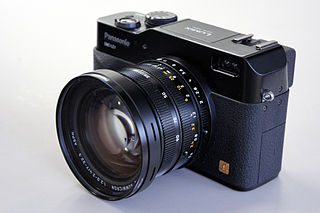
A single-lens reflex camera (SLR) is a camera that typically uses a mirror and prism system that permits the photographer to view through the lens and see exactly what will be captured. With twin lens reflex and rangefinder cameras, the viewed image could be significantly different from the final image. When the shutter button is pressed on most SLRs, the mirror flips out of the light path, allowing light to pass through to the light receptor and the image to be captured.

A camera is an instrument used to capture and store images and videos, either digitally via an electronic image sensor, or chemically via a light-sensitive material such as photographic film. As a pivotal technology in the fields of photography and videography, cameras have played a significant role in the progression of visual arts, media, entertainment, surveillance, and scientific research. The invention of the camera dates back to the 19th century and has since evolved with advancements in technology, leading to a vast array of types and models in the 21st century.

A digital camera, also called a digicam, is a camera that captures photographs in digital memory. Most cameras produced today are digital, largely replacing those that capture images on photographic film. Digital cameras are now widely incorporated into mobile devices like smartphones with the same or more capabilities and features of dedicated cameras. High-end, high-definition dedicated cameras are still commonly used by professionals and those who desire to take higher-quality photographs.

The Four Thirds System is a standard created by Olympus and Eastman Kodak for digital single-lens reflex camera (DSLR) design and development. Four Thirds refers to both the size of the image sensor (4/3") as well as the aspect ratio (4:3). The Olympus E-1 was the first Four Thirds DSLR, announced and released in 2003. In 2008, Olympus and Panasonic began publicizing the Micro Four Thirds system, a mirrorless camera system which used the same sensor size; by eliminating the reflex mirror, the Micro Four Thirds cameras were significantly smaller than the Four Thirds cameras. The first Micro Four Thirds cameras were released in 2009 and the final Four Thirds cameras were released in 2010; by that time, approximately 15 Four Thirds camera models had been released by Olympus and Panasonic in total. The Four Thirds system was quietly discontinued in 2017, six years after the final cameras were released.

Minolta Co., Ltd. was a Japanese manufacturer of cameras, camera accessories, photocopiers, fax machines, and laser printers. Minolta Co., Ltd., which is also known simply as Minolta, was founded in Osaka, Japan, in 1928 as Nichi-Doku Shashinki Shōten. It made the first integrated autofocus 35 mm SLR camera system. In 1931, the company adopted its final name, an acronym for "Mechanism, Instruments, Optics, and Lenses by Tashima".

Canon EOS is an autofocus single-lens reflex camera (SLR) and mirrorless camera series produced by Canon Inc. Introduced in 1987 with the Canon EOS 650, all EOS cameras used 35 mm film until October 1996 when the EOS IX was released using the new and short-lived APS film. In 2000, the D30 was announced, as the first digital SLR designed and produced entirely by Canon. Since 2005, all newly announced EOS cameras have used digital image sensors rather than film. The EOS line is still in production as Canon's current digital SLR (DSLR) range, and, with the 2012 introduction of the Canon EOS M, Canon's mirrorless interchangeable-lens camera (MILC) system. In 2018 the system was further extended with the introduction of the EOS R camera, Canon's first full frame mirrorless interchangeable lens system.

An autofocus optical system uses a sensor, a control system and a motor to focus on an automatically- or manually-selected point or area. An electronic rangefinder has a display instead of the motor; the adjustment of the optical system has to be done manually until indication. Autofocus methods are distinguished as active, passive or hybrid types.

A digital single-lens reflex camera is a digital camera that combines the optics and mechanisms of a single-lens reflex camera with a solid-state image sensor and digitally records the images from the sensor.

The Canon PowerShot G is a series of digital cameras introduced by Canon in its PowerShot line in 2000. The G series cameras are Canon's flagship compact models aimed at photography enthusiasts desiring more flexibility than a typical point-and-shoot without the bulk of a digital single-lens reflex camera.

Lumix is Panasonic's brand of digital cameras, ranging from pocket point-and-shoot models to digital SLRs.

A bridge camera is a type of camera that fills the niche between relatively simple point-and-shoot cameras and interchangeable-lens cameras such as mirrorless cameras and single-lens reflex cameras (SLRs). They are often comparable in size and weight to the smallest digital SLRs (DSLR), but lack interchangeable lenses, and almost all digital bridge cameras lack an optical viewfinder system. The phrase "bridge camera" has been in use at least since the 1980s, and continues to be used with digital cameras. The term was originally used to refer to film cameras which "bridged the gap" between point-and-shoot cameras and SLRs.

Live preview is a feature that allows a digital camera's display screen to be used as a viewfinder. This provides a means of previewing framing and other exposure before taking the photograph. In most such cameras, the preview is generated by means of continuously and directly projecting the image formed by the lens onto the main image sensor. This in turn feeds the electronic screen with the live preview image. The electronic screen can be either a liquid crystal display (LCD) or an electronic viewfinder (EVF).

A mode dial or camera dial is a dial used on digital cameras to change the camera's mode. Most digital cameras, including dSLR and SLR-like cameras, support modes, selectable either by a rotary dial or from a menu. On point-and-shoot cameras which support modes a range of scene types is offered. On dSLR cameras and SLR-like cameras, mode dials usually offer access to manual settings. The more compact point-and-shoot cameras, and cameras offering a great many modes, do not have mode dials, using menus instead. Some SLR lenses themselves offer control over things such as aperture, reducing the need for mode support in the camera body.

This article details lensesfor single-lens reflex and digital single-lens reflex cameras. The emphasis is on modern lenses for 35 mm film SLRs and for "full-frame" DSLRs with sensor sizes less than or equal to 35 mm.

The Pen, or PEN series is a brand of Olympus. It was used on analog half-frame compact and SLR models from 1959 until the early 1980s. In 2009, Olympus released the PEN E-P1, a digital mirrorless interchangeable-lens camera, which opened the range of Digital PEN models, which are still sold today. Olympus Corporation's camera division since has been bought by Japan Industrial Partners, and run under the OM Digital Solutions name. They continue to run the Digital PEN series.

The Micro Four Thirds system is a standard released by Olympus Imaging Corporation and Panasonic in 2008, for the design and development of mirrorless interchangeable lens digital cameras, camcorders and lenses. Camera bodies are available from Blackmagic, DJI, JVC, Kodak, Olympus, OM System, Panasonic, Sharp, and Xiaomi. MFT lenses are produced by Cosina Voigtländer, Kowa, Kodak, Mitakon, Olympus, Panasonic, Samyang, Sharp, Sigma, SLR Magic, Tamron, Tokina, TTArtisan, Veydra, Xiaomi, Laowa, Yongnuo, Zonlai, Lensbaby, Venus Optics and 7artisans amongst others.
This article discusses the cameras – mainly 35 mm SLRs – manufactured by Pentax Ricoh Imaging Corp. and its predecessors, Pentax Corporation and Asahi Optical Co., Ltd.. Pentax must not be confused with Pentax 6x7 or Pentax 67 which are 120 medium format 6x7cm film cameras.

The Panasonic Lumix DMC-GH1 is a digital mirrorless interchangeable lens camera adhering to the Olympus and Panasonic developed Micro Four Thirds System (MFT) system design standard. Panasonic classified the GH1 as a hybrid stills/video camera and the GH1 was introduced and marketed as a higher end camera than Panasonic's first MFT camera, the stills only, non-video capable Lumix DMC-G1.

A mirrorless camera is a digital camera which, in contrast to DSLRs, does not use a mirror in order to ensure that the image presented to the photographer through the viewfinder is identical to that taken by the camera. They have come to replace DSLRs, which have historically dominated interchangeable lens cameras. Other terms include electronic viewfinder interchangeable lens (EVIL) cameras and compact system cameras (CSCs).






















